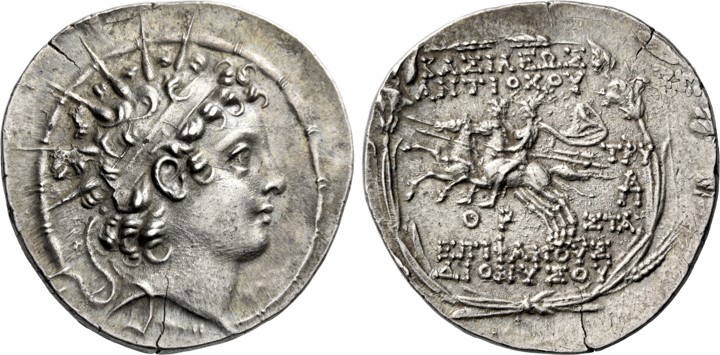144 BCE - 142 BCE | ΒΑΣΙΛΕΩΣ / ΑΝΤΙΟΧΟΥ – ΕΠΙΦΑΝΟΥΣ / ΔΙΟΝΥΣΟΥ
Overstriking coin
Antioch_Numismatica_Ars_Classica,_146,_8_May_2024,_2256.jpg
[1]
|
|
Sale(s)Sale(s) ᵖ:
|
Previously privately purchased from Bank Leu on 14th December 1973 = Leu, Winterthur sale 8, 2021, 148 = Numismatica Ars Classica, 146, 8 May 2024, 2256
|
| Private collection(s)Private collection(s) ᵖ:
|
From the Regierungsrat Dr. iur. Hans Krähenbühl collection
|
|
Description
| ObverseInscription or printing placed on the obverse.:
|
Radiate and diademed head r.
|
ReverseInscription or printing placed on the reverse.:
|
ΒΑΣΙΛΕΩΣ / ΑΝΤΙΟΧΟΥ – ΕΠΙΦΑΝΟΥΣ / ΔΙΟΝΥΣΟΥ (Greek) The Dioscuri galloping l., holding lances, in r. field, TPY above monogram above ΣTA, below horses, OP. All within wreath of lily, ivy and grain leaves and ears.
|
Mint and issuing power
Chronology
| FromIdentifies the initial date in a range assigned in a numismatic context. 144 BCE toIdentifies the final date in a range assigned in a numismatic context.. 142 BCE
|
Hellenistic 323-30 BC  periodTime period of the numismatic object. periodTime period of the numismatic object.
|
Physical description
MetalThe physical material (usually metal) from which an object is made.: Silver 
|
WeightWeight of the numismatic object (in grams). in grams: 16.4616.46 g <br />16,460 mg <br />
|
DenominationTerm indicating the value of a numismatic object. Examples: tetradrachm, chalkous, denarius.: tetradrachm 
|
|
| DiameterDescribes diameter of an object (in mm).: 3232 mm <br />3.2 cm <br />
|
StandardStandard.: Attic
|
References
Description
| ObverseInscription or printing placed on the obverse.:
|
|
ReverseInscription or printing placed on the reverse.:
|
|
Mint and issuing power
Chronology
| FromIdentifies the initial date in a range assigned in a numismatic context. toIdentifies the final date in a range assigned in a numismatic context..
|
periodTime period of the numismatic object.
|
Physical description
| DenominationTerm indicating the value of a numismatic object. Examples: tetradrachm, chalkous, denarius. ᵖ:
|
tetradrachm 
|
StandardStandard. ᵖ:
|
Attic
|
References
References
- ^ Houghton, Arthur - Lorber, Catharine C. - Hoover, Oliver D. (2008), Seleucid coins : a comprehensive catalogue. Part 2, Seleucus IV through Antiochus XIII, 2 v., New York - Lancaster - London, (xxx), 120 p. of plates : ill., maps, tables

